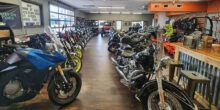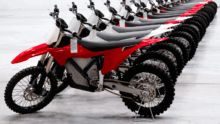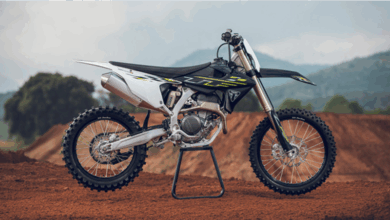Polaris moves to reduce dealer inventories
ATV sales posted only moderate growth last year among all manufacturers, about 4%, and Polaris’ ATV retail numbers were about the same. Consequently, says Bennett Morgan, Polaris’ ATV manager, the company is responding by asking for lower orders from its DSM force. This is, Morgan told Powersports Business, a move to drive inventory levels down to more manageable levels as the 2005 transition approaches.
“It is about us trying to be a better partner for our dealers,” said Morgan.
Morgan says Polaris is constantly looking at inventory levels and those levels are not “much more” than they were last year. Polaris’ approach is not a reaction to anything negative, he said.
“We expect 2004 to be a good year and we expect to grow retail sales,” he said. “We expect to see modest single growth out of Polaris ATV retail and, frankly, ATV retail in general.”
Worst case scenario for Morgan? Polaris holding its marketshare as No. 3 among the seven major ATV manufacturers.
“Last year we had a war and had an economy that was struggling in the first half — those were huge issues for the industry,” said Morgan. “If you look at where industry sales were through June, we were at minus four for the year; we ended up positive at the end of the year.”
The fear of war can be much worse than war when it comes to sales according to Morgan. Once the campaign starts, sales tend to come back. They did in the ATV market as the uncertainty principle was raised for potential ATV buyers.
“We had some pretty acute external forces that hurt 2003, right now the economy is in better shape than it was months ago,” claims Morgan. “There is still the threat of terrorism and additional war initiatives, but my sense is that the risk of that is far less than it was last year.”
INDUSTRY INVENTORY IMPROVES
Morgan says other OEM inventory positions are in better balance than they were last year. “I think there were a lot of manufacturers, most notably Honda, that were in a pretty difficult position on non-currents,” he said. “On one hand they have to program those things so they have to get aggressive on it, but they may not have had the right product and the right product mix.” Morgan said he doesn’t see this as being the case for ’04 and the prospects look much better than a year ago at this time.
Morgan also said that he believes 2004 will be much more predictable for the OEMs and there will be far less inventory pressure. He also made a prediction that the industry will still remain aggressive on sales promotion, but it may start to slow.
“This industry spends a lot on sales promotion,” according to Morgan. “But I don’t think it will continue at this unprecedented growth rate, and that will bode well for all the OEMs.”
A potential problem for Polaris dealers is the possibility of cannibalizing sales from the carburated Sportsman 700 Twin model to the newer Sportsman 700 Twin EFI model with electronic fuel injection. Morgan maintains that the market will respond well to the EFI model and Polaris will continue to monitor sales numbers on the models before making any decisions.
“We did a fair amount of ‘voice of customer’ work on this issue and we think there are a fair amount of people interested in an EFI model,” he said. “And there are a lot of people asking for and about the benefits of EFI; this is the first time it’s really been offered in a widespread, production ATV.”
While some people may be leery of new technology, Morgan said more consumers are “early adopters” and will respond positively to new technology in an ATV.
“We aren’t going to take away the carbed 700 at this point,” Morgan explained. “We’ll monitor how the marketplace votes with dollars and if it wants both, Polaris will keep both available.” But he also says if the market dictates, the carburated 700 will go. Though that decision won’t be made any time soon.
POLARIS STRONG IN YOUTH MODELS
On the youth side, Polaris is excited about 2004, and according to the MIC, it should be. The numbers for youth model sales through November 2003 indicated Polaris was outselling its nearest competitor almost two to one.
“Polaris is, and always has been, a reasonably aggressive and innovative company,” Morgan explained. “And we were really the first of the manufacturers reporting to the MIC to pounce aggressively into the youth market. My sense is that in ’04 and ’05 we will become more aggressive in the youth market and meet the changing demands of this marketplace.”
Last year Polaris redesigned two of its youth machines to mimic the newly-released Predator 500. According to Morgan, that made Polaris’ youth line more compelling to the consumer and improved its standing atop the market.
Still, 2004 shows room for improvement as internal Polaris data indicates many of its dealers are not ordering youth models as aggressively as Morgan would like.
“As the marketplace changes, there are a lot of youth ATV options,” said Morgan. “Sometimes dealers, unfortunately, chase margin; I understand that.”
ASIAN MANUFACTURERS WATCHED
The changes and options to which Morgan refers are competing models from Asian manufacturers who do not report sales to the MIC and do not follow CPSC guidelines. According to Morgan, the MIC numbers only indicate about 70% of the actual youth models sold in the U.S.
“This is a big marketplace and we have more competitors in the youth ATV market than we do in Polaris’ other markets,” Morgan explained. “We have MIC manufacturers who have developed a strong product, but we also have other Asian companies who can come in at a lower price and can channel through broader end businesses that may be in a less desirable position for Polaris.”
Morgan warns, however, that it may be a mistake to chase margin in this regard because it can end up hurting a dealer’s consumer base.
“Sometimes a dealer will look at a lower-cost product in terms of the margin it will get them,” he said. “And many think it is not worth the hassle, but we want to get customers young and keep them on Polaris for life.”
The margin chasing that Morgan is concerned with may be a direct result of the rising costs dealers face through insurance and operating costs.
“And some of those (Asian) companies refuse to follow the CPSC guidelines for a safe product,” Morgan reiterated. “There is more competition and some dealers are making choices that are short-term and price oriented.”
Morgan admits it is a sales force responsibility to get dealers “fully engaged” in the youth market. He says he wants the Polaris ATV sales force to recognize the volume and opportunity a youth ATV can bring a dealer.
Another misconception some dealers have, according to Morgan, is that youth ATV sales are seasonal and only come in the fourth quarter.
“The truth is that only 40% of the product is sold in the fourth quarter,” he stated. “There are a lot of other sales occurring throughout the year and we have to get the communication to our sales force and channels.”
Youth models still see the largest numbers in the U.S., with Canada also showing impressive sales numbers, says Morgan. In Europe, the major ATV manufacturers do not have as strong a foothold and the market is much more level for Asian firms than it is in North America.
Morgan explained that a lot of what we call “youth” in the U.S. is being sold as street-legal “quadracycles” in Europe. While it may be an attractive market for its Asian competitors, Morgan does not foresee Polaris going in that direction in Europe any time soon.
GOOD 2004 FORECAST
Morgan sees good things for 2004, not only for Polaris but the industry as a whole.
“We are going to try and get back to number one in both ATV and snowmobile sales and I have to make sure ATV keeps toward that goal,” he concluded. “As we embark on other important initiatives, first and foremost we have to focus on driving ATV sales forward and that we provide the tools and communication to both our sales force and dealers.”





